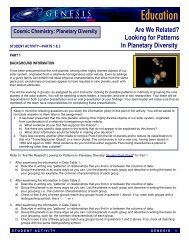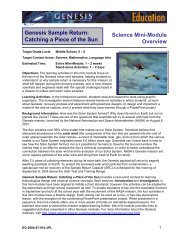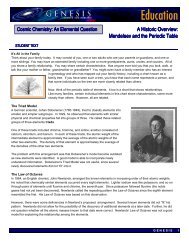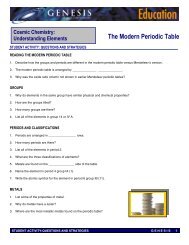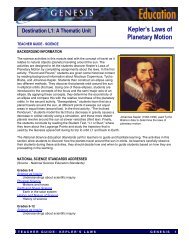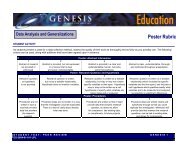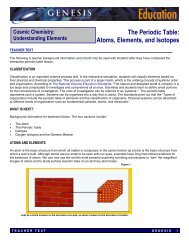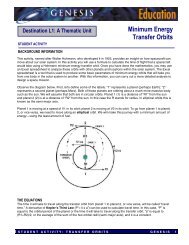Genesis Launch Vehicle: The Delta Rocket - Genesis - NASA
Genesis Launch Vehicle: The Delta Rocket - Genesis - NASA
Genesis Launch Vehicle: The Delta Rocket - Genesis - NASA
You also want an ePaper? Increase the reach of your titles
YUMPU automatically turns print PDFs into web optimized ePapers that Google loves.
planes that land on the skid strip, which is a runway named for early missiles that landed on skids instead of wheels. Find<br />
the skid strip and <strong>Launch</strong> Complex 17 on a map of Kennedy Space Center on page 6 of this student text.<br />
During the last two weeks, the exact weight of <strong>Genesis</strong> is measured so that the third stage can be balanced. <strong>The</strong><br />
spacecraft is then mated to the third stage. <strong>The</strong> spacecraft, in the third stage, is transported to the rocket at night,<br />
moving no more than five miles per hour. <strong>Genesis</strong> is “under the hook” by 5:00 AM. <strong>The</strong> spacecraft in the can is lifted to a<br />
white room in which it stays for about 4 hours so any contamination in the white room can be filtered out. <strong>The</strong> spacecraft is<br />
then integrated, the canned segments are taken apart and electrical connections are made.<br />
Finally the fairings are installed. <strong>The</strong> fairings have doors so that the spacecraft can be accessed. <strong>The</strong>re are blankets<br />
attached to the fairings that have to be tied back because the <strong>Genesis</strong> spacecraft comes very close to the fairings. View<br />
images of technicians working on the <strong>Genesis</strong> spacecraft at:<br />
http://www.genesismission.org/mission/viewinggallery/index.html<br />
<strong>NASA</strong><br />
<strong>The</strong> location to be used to launch <strong>Genesis</strong> is<br />
Complex 17, a large, fenced area of several<br />
acres. Both the <strong>Delta</strong> II and <strong>Delta</strong> III rockets<br />
are launched from this complex. <strong>The</strong>re are<br />
two launch pads (17A and 17B), a<br />
blockhouse, ready room, shops and other<br />
facilities needed to prepare service and<br />
launch the rockets. <strong>Genesis</strong> is launched on<br />
pad 17 A. <strong>The</strong> pads are concrete-hard<br />
stands.<br />
<strong>Launch</strong> Complex 17<br />
<strong>The</strong> gantry is the highly visible service<br />
structure located next to the launch pad. It contains large cranes, which are<br />
used to erect the rocket. On the opposite side of the pad from the gantry is<br />
the umbilical tower. This tower has lines that are used to load propellant and<br />
other components into the rocket.<br />
After fueling is completed and final<br />
systems checks have been made, a<br />
specialist in charge will give<br />
permission to “go” for launch. At this<br />
point the countdown is completely<br />
automated. <strong>The</strong>re is no person that<br />
pushes the launch button. If trouble<br />
develops, even at a fraction of a<br />
second before launch, the computer<br />
senses it and the engines are shut<br />
down. During a successful launch the<br />
temperature on the pad can be over<br />
1900 degrees Celsius (3,452 degrees<br />
Farenheit). <strong>The</strong>re are special heat<br />
<strong>The</strong> <strong>Genesis</strong> spacecraft being encapsulated resistant surfaces placed around<br />
inside the fairing.<br />
equipment for protection. Thousands<br />
of gallons of water are also poured<br />
onto the launch pad to help sound abatement and to cool it down. <strong>The</strong> water dumped<br />
on the pad is momentarily turned to steam which is invisible. <strong>The</strong> force of the rocket<br />
exhausts blasts it away into the cooler air around the pad, causing the steam to<br />
condense as small water droplets, forming the familiar white cloud.<br />
<strong>The</strong> first stage of a <strong>Delta</strong> II rocket is<br />
lifted up the gantry.<br />
<strong>NASA</strong> <strong>NASA</strong><br />
<strong>Genesis</strong> will employ a single boost-to-orbit trajectory with a flight azimuth of 95 degrees. At 35.6 seconds after launch, the<br />
rocket will reach Mach 1. At just over one minute into the launch, the solid motors burn out and are separated from the<br />
rocket. <strong>The</strong> next significant event is main engine cutoff, which occurs at four minutes after launch. Eight seconds later, the<br />
STUDENT TEXT: THE DELTA ROCKET<br />
GENESIS<br />
5



